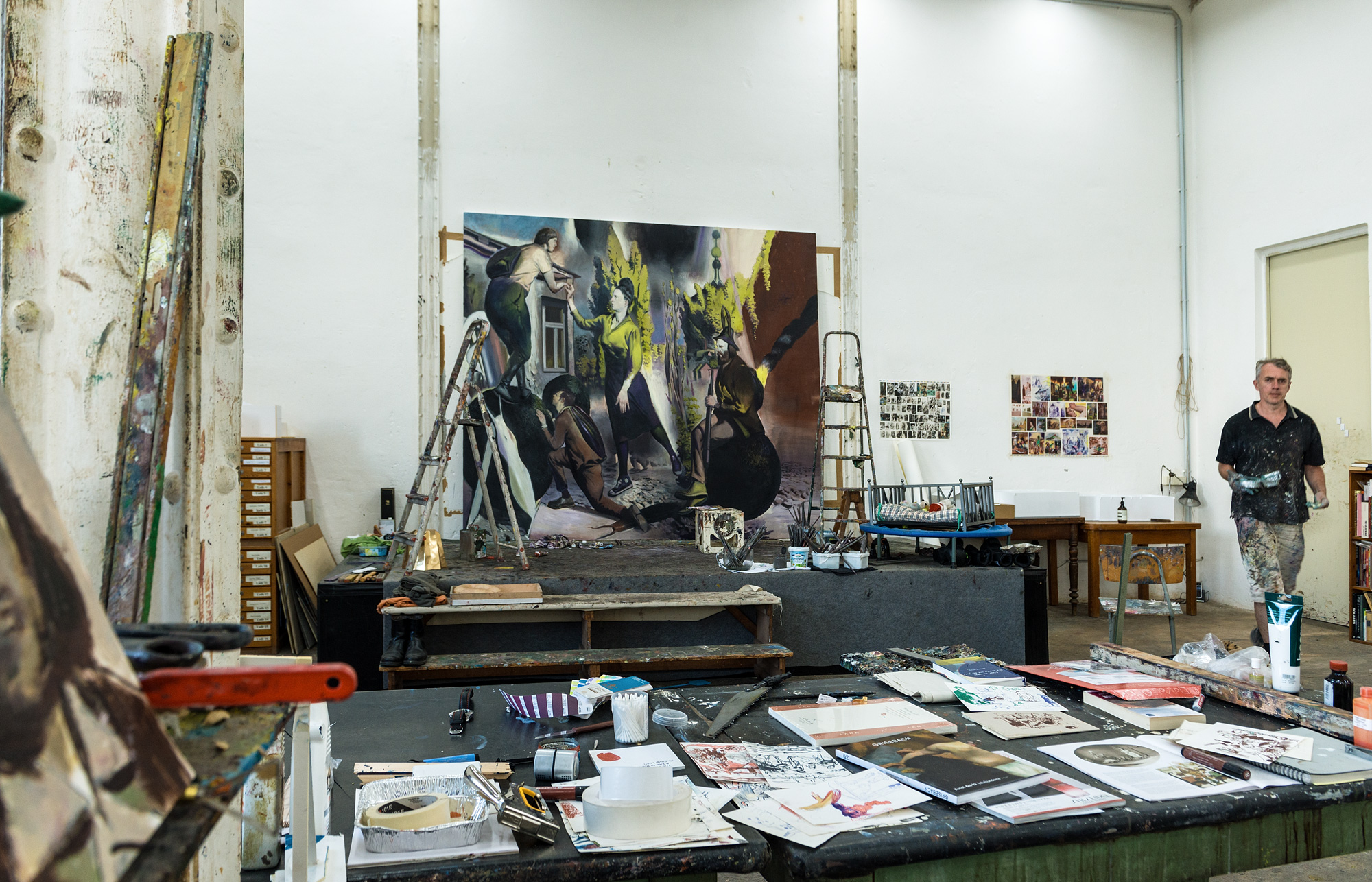
Neo Rauch
Mechanic of Dreams
Interview by David Molesky // Portrait by Uwe Walter
Neo Rauch once expanded a variation on Descartes famous meditation and said, “I dream therefore I am.” In an era where thinking is often outsourced to computers, dreaming is an activity intrinsically human. Dreams can magically leave us feeling simultaneously connected to universes of time—present, past, and future. Neo Rauch’s work stands before us like a portal that links our era with all of its Postmodern confusion back to a time when fairy tales served as plausible short stories. With feet firmly rooted in his native Saxony, Rauch engages an ethereal undercurrent of symbol and storytelling.
Neo Rauch has often said that his overall mission is to re-enchant the world and take off where the Romantics left off. In reading many of his previous interviews, one gets the sense that Rauch engages a spectrum of pre-Enlightenment and Romantic occult wisdom. He mentions the Akasha, bursts of pantheism, time continuum, and Caspar David Friedrich’s Monk by the Sea as representing the awareness of one’s placement within a grand design.
Allowing hypnagogic visions to guide his foray into new compositions, Rauch works mostly in stream-of-consciousness with no preliminary drawing. Flowing from his trance state, the painting takes on a life of its own. Rauch spoon-feeds his creature-like creations from brushes held by large, clumsy-looking gardening gloves with paint he mixes on the floor in containers before his canvases. He keeps a schedule like a factory worker: 9 AM–7 PM, five days a week, working on three to five large canvases at a time. On the weekend he lets the paint dry, takes a break from the studio, and spends time with his family working in his garden.
For three decades, Rauch’s efforts have resulted in his own distinct world populated by humans and humanoid subjects that he refers to as his paintings’ personnel. These characters interact in an atmospheric space that challenges us with scale change, perspective shifts, and intense passages of color. The integration of historical architecture and dress, with the special effects of science fiction, spans the viewpoint across different eras of human history.
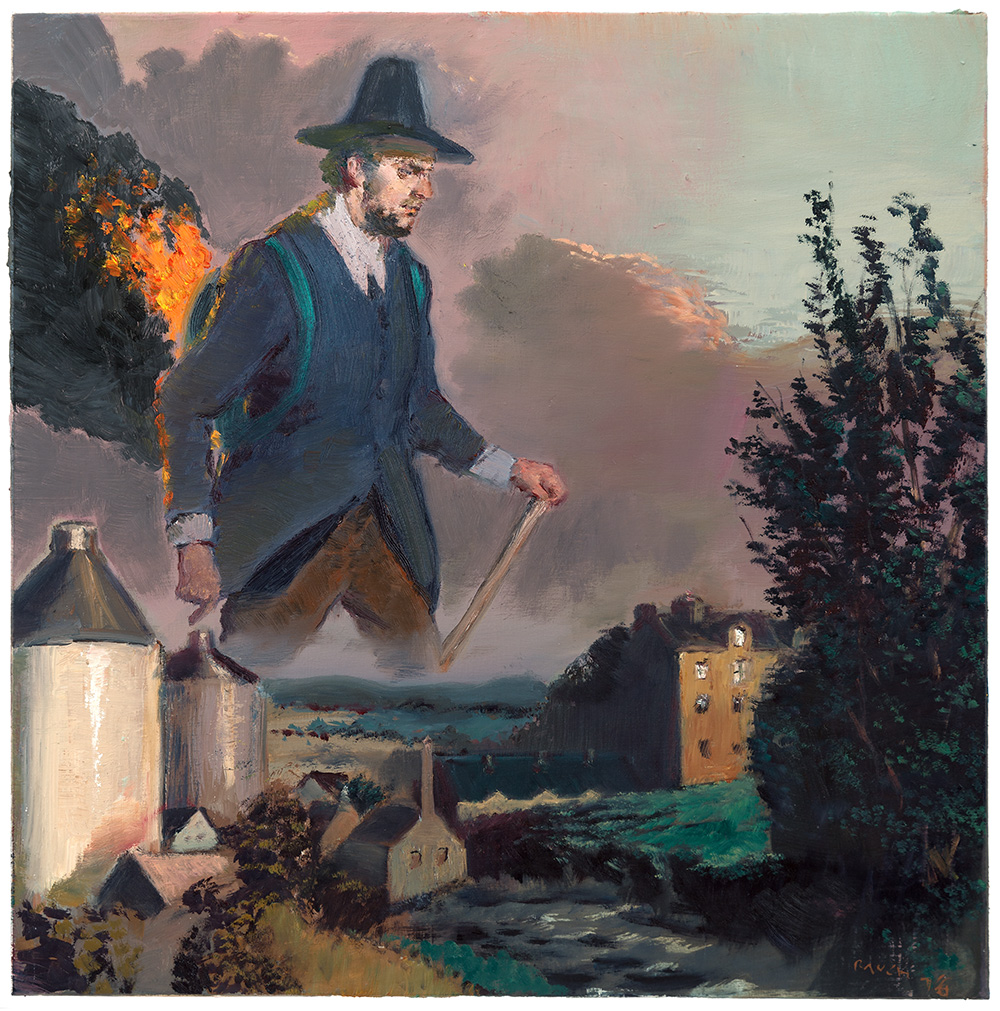
Neo Rauch was raised by his grandparents in Aschersleben after a train accident put an early end to the lives of his young parents, who at 19 and 21, were both still art students. Rauch would later attend his parents’ alma mater, Hochschule für Grafik und Buchkunst Leipzig (Leipzig Academy of Visual Arts), receiving an MFA and becoming a professor there from 2005–2009. Having remained in Leipzig his entire adult life, Rauch feels a deep connection to the intellectual and creative legacy of the region’s terroir. Since the early ’90s, Rauch has made a top floor studio space in an old cotton mill the epicenter of his creative activities, with his wife, casein painter Rosa Loy, working in another studio just across the hall.
Twenty-five years ago, Rauch had his first solo exhibition with Eigen+Art, which is still his principal gallery in Europe. At the turn of the millennium, he was picked up by New York gallerist David Zwirner, followed by a solo show at the Metropolitan Museum of Art in 2007. When Rauch turned 50 in 2018, he was given a retrospective exhibition, titled Dromos, that filled all four floors of the Museum de Fundatie in Zwolle, Netherlands. This past summer, Rauch and Loy designed the costume and set for the Bayreuth Festival’s production of Wagner’s Lohengrin, which will continue to be staged for the next three summer festivals. Reopening this April at The Drawing Center in Manhattan, an exhibition traveling from the Des Moines Art Center, will feature 170 drawings by Rauch on A4 standard paper.
Over the Holiday break, Rauch was able to squeeze in an interview with Juxtapoz as he prepares for a solo exhibition opening March 26, 2019 at David Zwirner’s new gallery space in Hong Kong. David Molesky fired off a set of questions hoping to gather insight into the mind and process of the most epic painter hailing from Eastern Germany. ––Juxtapoz
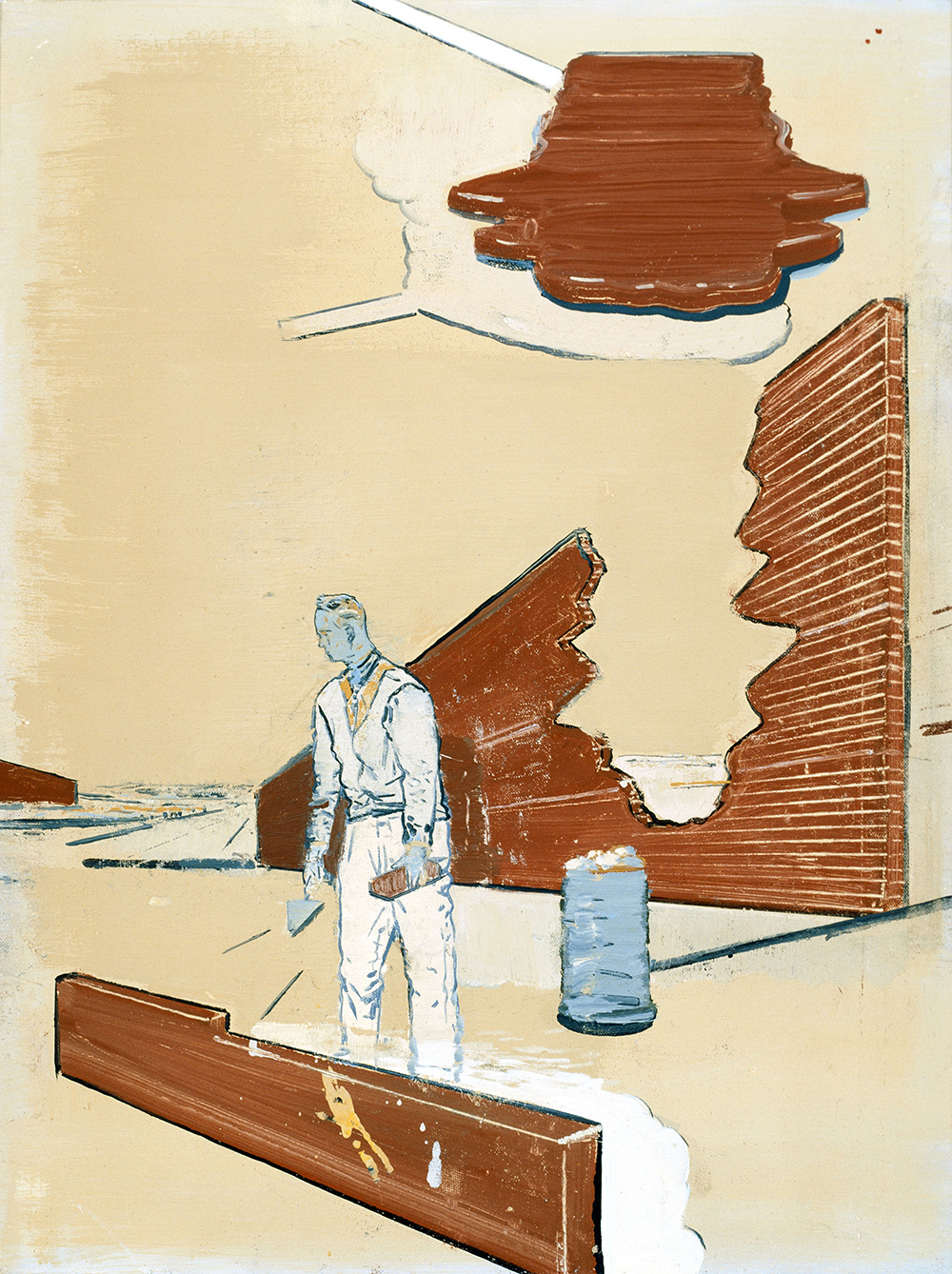
David Molesky: I felt so fortunate that I was able to see your exhibition, Dromos. Retrospectives are an unprecedented opportunity for an artist to reflect and to make comparisons between images. What was the takeaway realization upon seeing your work filling the Museum de Fundatie in Zwolle, Netherlands?
Neo Rauch: It was like a family reunion, a great homecoming with touching moments of reuniting and recognition. A few of the pictures I had not seen for a long time, and all—really all, even the older ones, somehow aged well.
Also, the interlocking of images from two decades does not seem abrupt or inorganic at any point; on the contrary, everything harmonizes in the most excellent way without giving up tension.
It is inevitable that an artist who has worked prolifically for decades will find some repetition and certain aspects that are continuous. Despite a stated resistance to analyzing your pictures, are there any patterns in your narratives which you cannot avoid noticing?
Certainly, there are recurrent patterns. Above all, probably the fact that the interactions of my characters are caught in a state of limbo; that they never really connect or even maintain eye contact. Also, I avoid, with very few exceptions, the eye contact between figures and viewer. I always perceive such stagings as indecent.
In addition, there may be props, such as the burning backpack or cannons, which appear directly or in modified form again and again. Architectural elements, such as factory chimneys and church towers, are also found again and again over the decades, as well as clouds of smoke! No smoke without fire.
It’s exciting that you recently translated your theater-scaled paintings into the third-dimension of opera. How has the opportunity to design costume and sets for Lohengrin affected your approach to painting? And how sensational that this has sparked a collaborative process with your wife Rosa Loy! I love that you stated, “It was easier than driving in the car together.” Will you collaborate on future projects?
This is not yet foreseeable; the impressions left by the stage design are still too fresh to serve as a mold for pictures. They have to cure first. The effect of the light in the room has, in any case, addressed the painter directly, and it remains to be seen how and if this experience is reflected on the canvases.
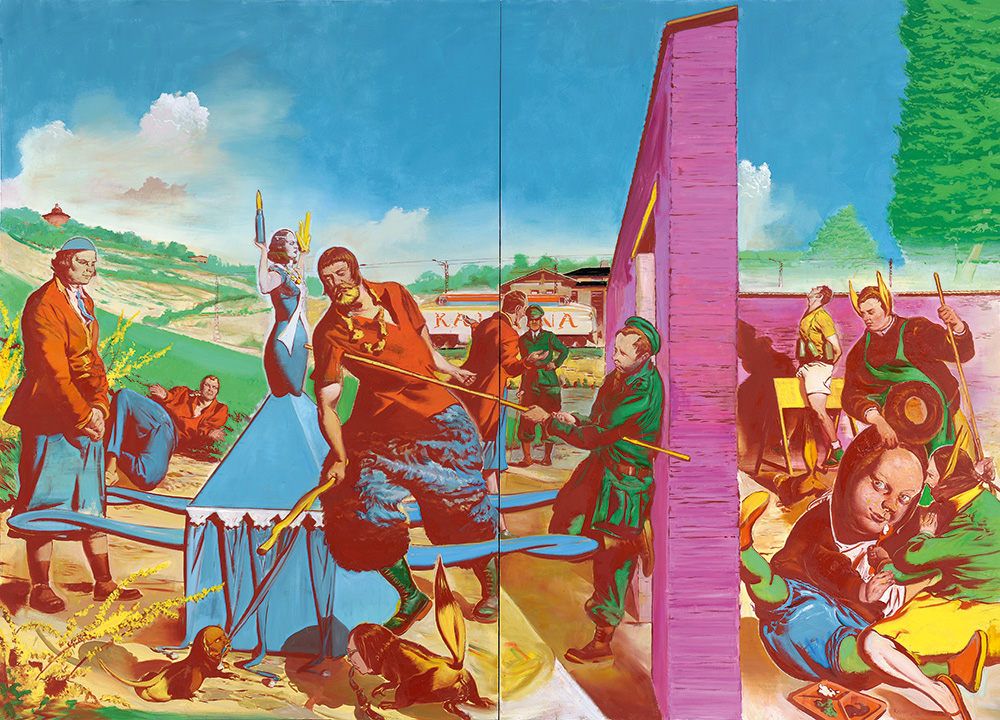
Yes, working with Rosa is indeed a great pleasure. She is very nimble—in the head and with the eyes—and thus, fills a fatal gap that gapes on my part. For the time being, there are no stage projects on the horizon, with the exception of our further work on Bayreuth Lohengrin.
I am looking forward to seeing your exhibition Neo Rauch: Aus dem Boden/From the Floor when it comes to The Drawing Center in Manhattan. How do you use drawing in your practice? I would imagine drawings, which are not preliminary, could be used as exercises to help you feel out various sensibilities, like what you’ve called “the moment prior to excess.” Ms. Loy must be helpful navigating these regards. She is an exceptional painter in her own right, and I’ve heard the only person you allow into your creative process?
As part of my work, the drawing is considered a kind of by-catch; she gets into the net, yet the hunt was meant for larger prey. These are, at best, finger exercises, which I complete in a trance-like state, and which take place in the run-up to a canvas project. However, they do not prepare them directly, but only charge the space between me and the canvas atmospherically. Yes, Rosa is actually the only person whose advice and help I ask for when needed. One should be picky and careful in this regard.
You’ve described that your initial motivation in beginning a composition comes from dreams or hypnagogic visions that can sometimes be as vague as a concept or a phrase. What techniques or rituals do you engage in to encourage yourself to remain in these kinds of mindstates?
I derive my pictures directly from dreams only in very rare cases. Rather, I try to simulate the mechanics of a dream event. That is, I go before the picture on the sloping path of free-flowing imagining. Gravity eventually brings things together, creating a common sound. The rational can assist at best. When she takes over the direction, propaganda or journalism arise.
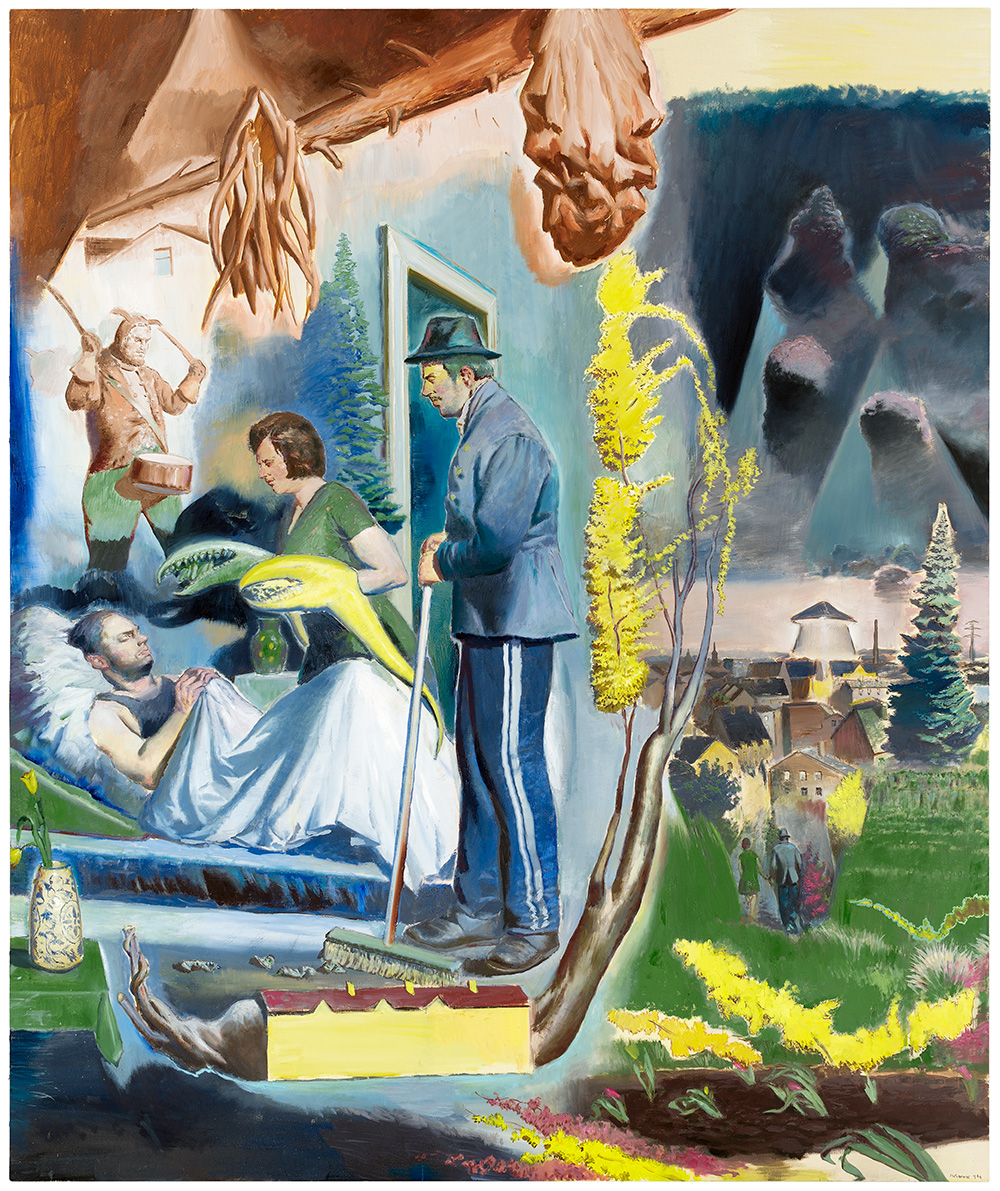
I am very interested to know more about your view of universal processes and their relation to the collective unconscious. Could you direct me to concepts that might deepen my understanding of how paintings work to bring re-enchantment to the world?
If one agrees that painting penetrates into spaces in which concepts become blurred and words lose their competence, then one accepts the management of undercurrents that unfold their own magnetism.
Julien Green, for example, described very clearly how the perception of a ray of light falling on an armchair became the starting point of an entire novel. The creative person differs from someone acting creatively, in that they become the medium through which something wants to speak to us.
As your work is celebrated more and more, society will inevitably want to find a message in your enigmatic paintings. What might you hope can be gleaned through your life project as a painter?
If it were possible to help a few people to suspect that under the concrete of reality a life pulsates, which forms branched mycelia and suddenly comes to the surface in the form of a work of art, then much would have been gained.
Art is unpredictable and eludes appropriation; it is a phenomenon that amazes us and should awaken a certain reverence for the possibilities of the creative. It is a gift and a miracle, and thus, the absolute opposite of what political commissars and ideologues want to make of it.
Having spent your entire life based in Leipzig, the largest city in the German state of Saxony, I am particularly intrigued by your sense of pride for this region and your engagement with its rich history of intellectual and artistic pursuits. In researching for this interview, I learned that the composer Wagner and the philosopher Nietzsche hail from Saxony. Through one of your interviews I also discovered Novalis, the great Romantic writer was also from Saxony. What common point of inspiration might foster like-minded creatives from this region?
It should by no means go unnoticed that Max Beckmann was born in Leipzig, and that J.S. Bach worked in the city as Thomaskantor (the music director of an internationally known boys’ choir founded in Leipzig). The cultural humus on which one could found their workshop here is so dense and nutrient-rich. The connecting element that led to this condensation may be atmospheric. Climatic conditions conducive to creative activity could also play a role. I just do not know.
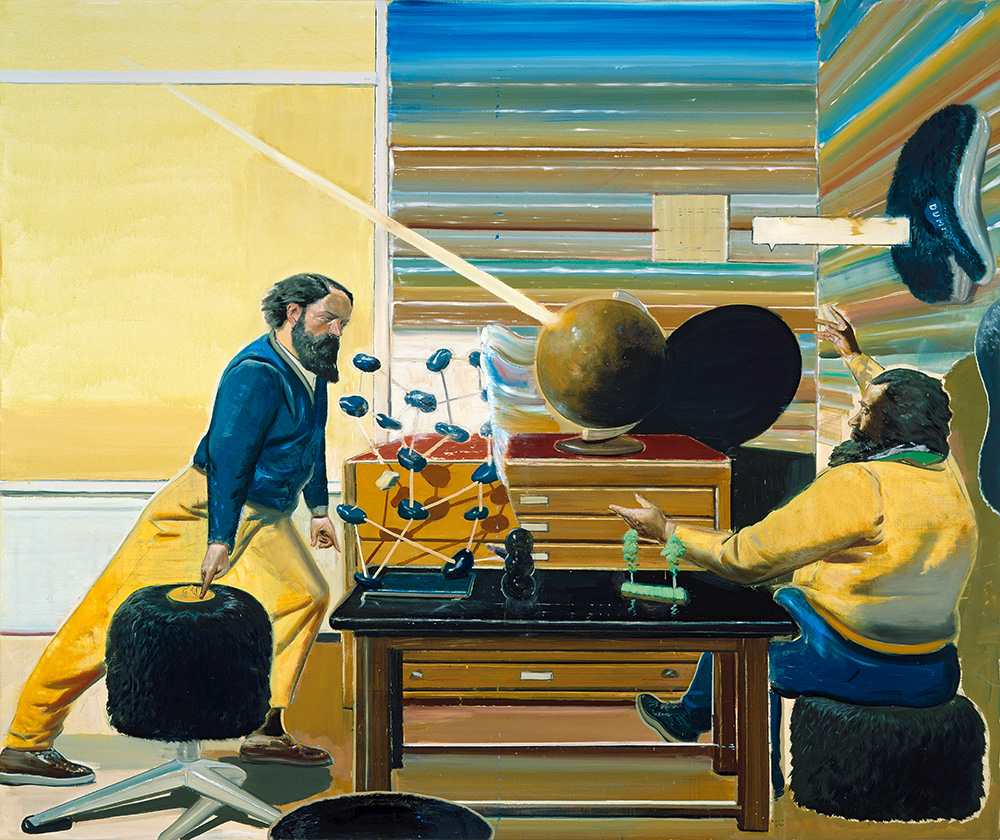
You are known internationally for your work as an individual artist, as well as for your position as a leading member of the New Leipzig School of painting. Tell me a little about how this community has supported each other and grown together. Has your role as the leading figure in this art community helped nurture your own work and sense of purpose?
The "New Leipzig School" is a term that emerged independently and outside of our consciousness as painting contemporaries. This label was pinned to us and did not appeal or seem fitting to everyone. Basically, it referred to the fact that in Leipzig, painting was still taught on a high figurative level, even though most “experts” in the early ’90s thought to abolish the utilization of brushes after 40,000 years. Painting was considered obsolete by these cretins, and those who nevertheless turned to it could be sure of their contempt and ignorance. In this respect, these years were a healing retreat, in the course of which it came to a thinning of the people, as only the real painter could resist the temptation of electronic cabinets and those of conceptualist seminars.
In any case, working in this blind spot was beneficial to my work, although the feeling of being marginalized was already gnawing at my pride. My first big personal exhibition with Judy Lybke at the gallery Eigen+Art in 1993 was a commercial flop, although the pictures were great! Only that at the time, the only people who saw it that way were Rosa, Judy, and me.
What will you be showing for your upcoming exhibition at David Zwirner in Hong Kong? What new developments have you explored in this new body of work, and are there any aspects of this work that have come about in consideration of the location?
There will be eight large (nearly 10’ x 9’) and seven small “handbag-sized” pictures. Whatever is new to them, new to my standards, that is, will only come to me much later. I am still too entangled in the sometimes agonizing development of these canvases to be able to attest to them a peculiarity. Also, the location of the presentation did not play a major role, yet rather an underlying one.
Neo Rauch’s Aus dem Boden / From the Floor will be on view at The Drawing Center, NYC, from April 12—July 28, 2019.





